Most ancient civilizations had some form of slavery. The ancient Hebrews adopted quite sophisticated rules around slaves and the behavior of their masters. The Hebrew concept of slavery seemed primarily to be about working off a debt. The monetary value of this debt may have been incurred by a market price, a crime or an accidental injury to someone. Any of these scenarios could put someone into debt-servitude to another person, creating a master-slave relationship.
In the Hebrew culture, the master would then set them free once the debt had been worked off, or when Jubilee was declared, which was a date where all slaves were to be set free. In effect, a Jubilee event was a bit like a ‘reset’, where people were effectively moved onto a new ledger.
Whatever was the case back then, we can observe that slavery and debt are ancient bed-fellows.
#PrussiaGate has sought to reveal the nature of an invisible enemy that has oppressed humanity for as long as we have kept records. The primary driver behind our research is that, “you can’t leave a captivity that you cannot see”. Understanding the nature of an oppressive captivity is critical to ensuring we don’t mindlessly recreate it again, simply by appointing different masters. Part I of this series provided a deep dive into how trade merchants become central bankers, effectively turning the entire world into a trade route that it can control. This evil desire to control free markets and trade human beings must never be repeated.
https://truthtrench.org/?p=3687&preview=true
In order to not repeat something, we must understand it. This is the purpose behind this research. We’ve shown how the invisible enemy infiltrated London’s merchant houses, and then launched itself from the Hanseatic League into London and the Bank of England during the Prussian window of 1666 – 1702. We’ve shown how the invisible enemy launched itself from Berlin into Washington DC, during the Prussian window of 1871 – 1917. More detail was provided in Not Since 1917 Part VI showing that the enemy’s most-recent host was a cabal of large global corporations and financial institutions. Washington DC was made a corporation, effectively creating a banking-version of the US, right alongside the original republic. The merchant bankers visualized financial access much like a port, through which they could trade.
https://truthtrench.org/?p=12522&preview=true.
1917 truly was a critical year for humanity. The banking cabal had been luring the US with loans throughout the 1800s, but total debt-servitude had been resisted. By the time the US entered World War 1, the central reserve bank had been installed, the structures for long-term debt-slavery had been established, and the host nation for the enemy’s global banking system had been chosen.
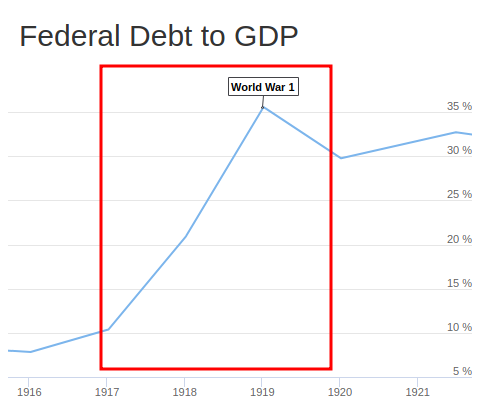
The Great Wars would begin the imposition of massive debt-loads and provide the landscape for treaties that would ultimately result in a created-layer of international governance. No nation on earth escaped it. With the wisdom of hindsight, we can see that this invisible enemy has long considered humans as tradable assets. However, from 1917 the arrival of central banking and excessive global debt made the global economy far more sophisticated, defining this next stage of human existence. The financial systems they created, and the creative methods of using debt to capture the minds of people are quite incredible. It has to be said, we truly have been enduring a formidable enemy.
But now, in this global game of hide-n-seek, it seems that this illusive invisible enemy, has been found.
Humanity is arriving at a significant turning point in history; awakening to the presence of an invisible ancient ruling-monarchy, while at the same time, sensing to throw it off and truly be free. Could we be collectively sensing that it is time for a Jubilee-style financial event? This is not an unreasonable question, particularly given that sovereign nations have been in debt to a global banking cabal for a very long time.
As we accept the idea that we’ve been enslaved within some kind of captivity, we’ve just taken the critical first step toward leaving. From this permission-point, we must understand the enemy’s playbook and patterns of our captivity. We do this because our enemy has weaponized ideology, meaning that even our strongly-held beliefs, fears and prejudices are all contributing to our own enslavement.
Let’s continue our exploration.
New money always does the trick:
Historically, the rule over people was done by kings and queens. Organized elections were not yet a reality, and monarchs were routinely appointed, often after a war. This authoritarian leadership structure meant the citizens needed to create a loud, visual uprising in order to communicate any dissatisfaction with the methods and policies of their ruling monarch. This was exactly what took place in the US prior to 1776. It is ironic that we still need to do this today in order to get the attention of our elected rulers representatives.
In Part 1 we revealed the origin of merchant created debt notes, or letters of credit, which became critical for global trade and the expansion of Great Britain during the late 1600s. The merchants worked with William III of Orange, the ruling monarch of the day, to launch the Bank of England:

The historic presence of these Hanseatic merchants is still recognized in London today:
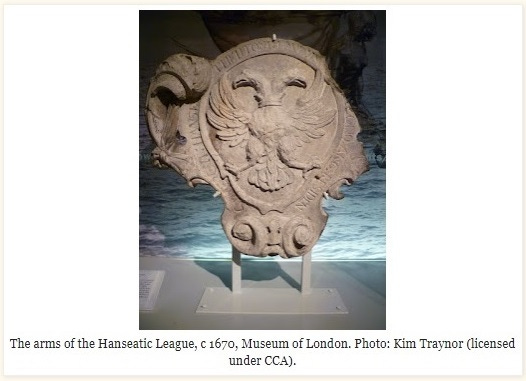
So, while the merchants were weaving an elaborate system of trade based out of London, what were the British people doing? During the late 1600’s, the citizens were becoming wise to excessive taxation and oppression, and a significant freedom-movement was forming against King Charles II. Republicanism had been growing prior to the English Civil War (1642–1651). This particular uprising was critical in the opening of the Prussian window of 1666 – 1702. For those interested in the broader discoveries that helped identify this historic window, you can read our article, “1666“.
https://truthtrench.org/?p=3621&preview=true
In summary, the fire of London in 1666 didn’t just destroy the Hanseatic Steelyard. It provided the impetus for new laws and large-scale rebuilding of the city. New money for these works was provided by the Bank of England, founded in 1694. Providing a rare glimpse into how ‘opposing’ monarchs worked together, the old City of London Corporation had its privileges stripped by a writ quo warranto by Charles II in 1683, who was under siege by the ‘deplorables’ of the day. They were soon restored by an Act of Parliament under William III of Orange in 1688-1690, following the Glorious Revolution. This was a classic Prussian paper shuffle. The transition was seamless, despite the nation having just lost a war and been assigned a new king. The invisible hand of ‘control’ was working quietly in the background. What appeared to be political advancement was really just a national transition into a new regime of control.
The Glorious Revolution ended a century of political dispute by confirming the primacy of England’s Parliament over the Crown; a principle established in the Bill of Rights 1689. This appeared to finally establish the authority of government with the people, but remember, London was now a modernized corporation. The unsettled ‘deplorables’ willingly stood down, believing they finally controlled their leaders; but it was all an elaborate hoax. William of Orange’s reign ended with his death in 1702, bringing this incredible transition-window to a close.
Obviously, any system of parliament gives people some level of influence. However, the illusion of people-power is critical to having the citizenry think they are free. The real influencers of any government are powerful corporations, or merchants, as was the case in London in the late 1600s.
The Hanseatic League merchants had become the invisible enemy. They, and the bankers that would follow, knew exactly what they were doing:
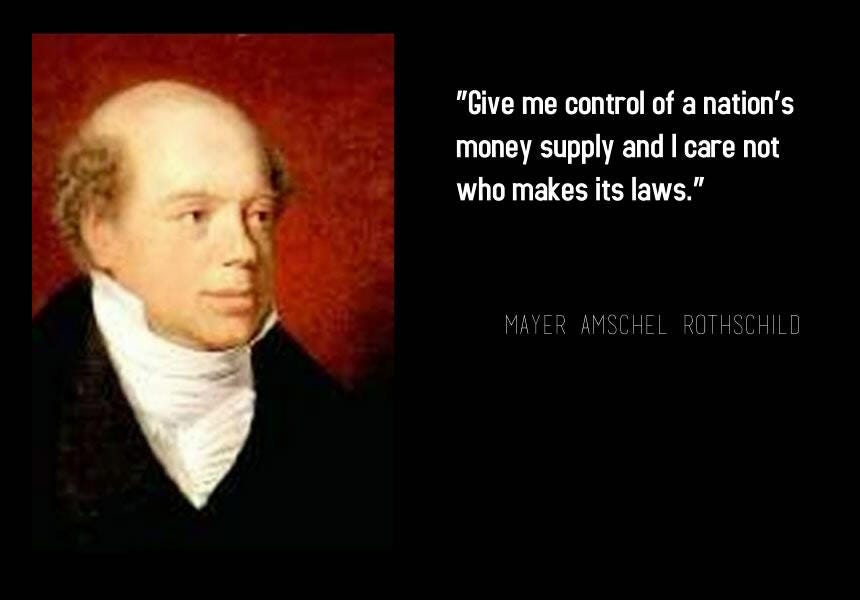
In his book Tragedy and Hope, Historian Carroll Quigley summed up the vision of the banking cabal perfectly:

In 1689, William III of Orange became the prevailing monarch who would road-test the innovative plan to place a sovereign nation into debt, thereby controlling its political system and its economy. To do this legally, the nation and its people had to be placed into the same jurisdiction as the banks. The required jurisdiction was the realm of corporations. For this grand deception to succeed and be accepted as fair, everything must appear to exist on an equal footing.
The corporation of London provided the legal structure that allowed for debt to be imposed upon a sovereign nation. A corporation cannot have authority over a citizen without their consent. Creating a corporate government, allowed the politicians to agree to corporate mandates, on behalf of its citizens. Having created the new corporate structures of London in 1689, the Bank of England was formed in 1694. The privately-owned bank became the Government’s financier, ready to fund its wars, which were suddenly emerging everywhere. This new bank would eventually place Europe into a deep debt, which has never really ended.
In order to issue debt notes to a national government, the banks hold government bonds as security, representing the true value of the nation and its people. At a personal level, people could now be offered loans from the banks, subject to a mortgage, which in Latin, means “death pledge”. The language perfectly matched the jurisdiction; debt exists in the realm of corpses. To ensure the legal right for a natural person to engage with a system of corpses, a “legal person” was re-defined to include a corporate entity, which could be a human or non-human:

The stage was set for the rise of corporations and non-government organizations.
As we peer back into history, we observe the earliest expression of centralized debt-slavery; all established during the 1666 – 1702 window in London by the Hanseatic merchants. Horribly, the appearance of new finance significantly expanded the scale of actual slavery, which was now government-sanctioned and aggressively funded as an emerging global business. In Great Britain, this would commence with the transport of African slaves into America, revealing the chilling connection between global banks and human slavery.
Cargo cult:
Let’s introduce Francis Dashwood to the story. He was a serious player in England’s new Government, under William of Orange. As his business career notes, Dashwood was a known slave trader:

Dashwood was loaning money to the Crown, immediately after William III of Orange took power. What influence must you have for a reigning monarch to borrow your money?
We introduce Francis Dashwood because it is time to introduce the horrific idea of human cargo. Working with the City of London Merchants and the English Royal family, Dashwood assisted the Royal African Company transport more African slaves to the Americas than any other company in the history of the Atlantic slave trade:

Originally named “Company of Royal Adventurers of England Trading with Africa”, the Royal African Company was created by Royal Charter:
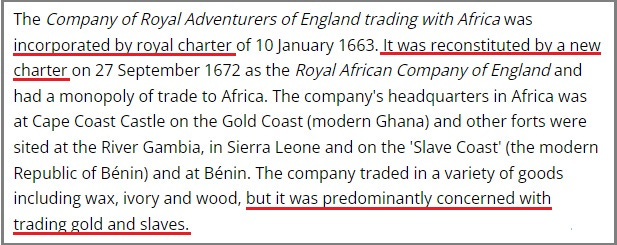
A Royal Charter is a formal grant issued by a monarch as letters patent. Historically, they were used to promulgate public laws; in place of private acts to grant a right or power to an individual or a body corporate. Before the 19th century, the grant of a Charter of Incorporation was the principal way of creating legal corporations. The merchant traders were considered so vital to England, that they joined universities, colleges, schools, municipalities, guilds and livery companies, as benevolent institutions. This allowed them the right to be granted a Royal Charter.
By 1660, the former Hanseatic League merchants had infiltrated British government to such an extent, that their companies essentially held the power of government and had international authority. “The Forgotten Majority” captures what was happening in London at this time:

Proving Chapman’s assertion about trading houses, The Royal African Company was founded by the British Royal Family in 1660:
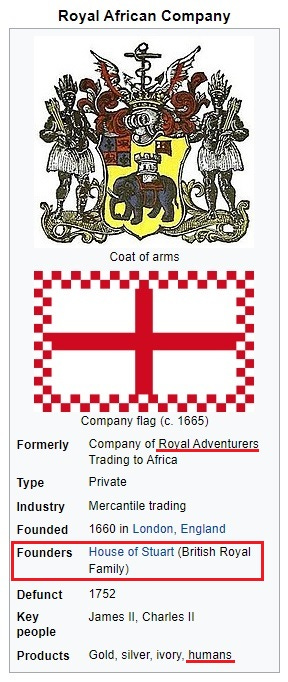
In yet another shout-out to the emergence of a new regime of merchant domination, the British Government passed the Navigation Act of 1660, aiming to promote the self-sufficiency of the British Empire by restricting colonial trade to England. It reconfirmed the requirement that all trade between England and the colonies to be carried in English or colonial vessels, and severely limited the trade of many North Carolina planters and merchants.
The London merchants saw global governance as a ‘navigation system’. Incredibly, it was harsh trade regulations that led to unrest that eventually resulted in the 1776 Declaration of Independence in America:
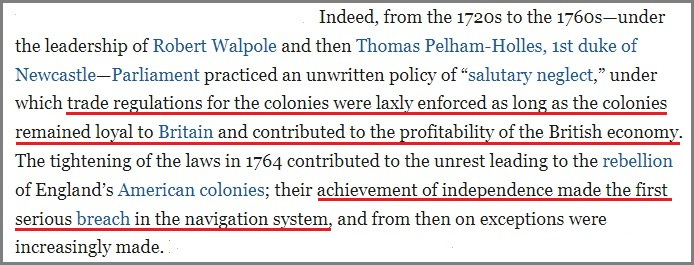
Back to Francis Dashwood; working with a company founded by the British Royal Family would ensure some incredible connections. These connections and global influence would not only create Dashwood’s significant business enterprise, but it would see him enter politics in 1708, while his brother Samuel Dashwood was Lord Mayor of London, a position which was effectively the CEO of the Corporation of London, created 12 years earlier. This was a serious family enterprise.
England and Europe now had a central bank printing money, while the merchant bankers expanded their trading operations, moving their ‘cargo’ around the world. This period solidified the role of merchants in the governance of the City of London. How was this achieved? Livery Companies. They were significantly modernized under the new City of London, and Liverymen were given extremely powerful and specific roles within this new society:

The English patriots rejoiced in 1689 when the Bill of Rights elevated their Parliament above the Crown. What they didn’t realize was that ALL voting power resided with the merchants, many of whom originated from the Hanseatic League. Under the new City of London Corporation, the merchants were also corporations. So, the authority to elect government did not reside with the citizenry, but with the influential corporations within the City.
Francis Dashwood was a freeman with The Worshipful Company of Vintners. This is one of the most ancient Livery Companies of the City of London, thought to date back to the 12th century. It is one of the “Great Twelve” as defined by an ‘order of precedence’, based on those companies’ contemporary economic or political power. The “Great Twelve” still exist today.
Ironically, Francis Dashwood, one of the earliest and most significant slave-merchants in London, held the title of “freeman”. Let this title marinate, for a moment. Dashwood and other liverymen were indirectly able to consolidate their business stability, because they also held the rights to elect political leaders and Sheriffs. These exclusive voting rights for liverymen lasted until The Reform Act of 1832.
The Royal African Company of England ultimately became insolvent in the 1720s. Its ports, settlements and factories in Africa were vested in the Company of Merchants trading to Africa incorporated by act of Parliament in 1750. It traded until 1821, after which it was abolished and its property vested in the Crown. Any distinction between the ruling monarchy and the merchant bankers in London, was essentially non-existent.
While such corporate power within government is shocking, it is not a new thing. We are only now waking up to a reality that has been hidden in plain sight, for a very long time.
Big Business:
In Hegel, War, The Owl and Salves of Bohemia, we showed that Frederick the Great attacked the Austrian Empire in Silesia in 1740, taking control of Moravia and Bohemia. That article mused that Bohemia’s ongoing slavery trade and serf villages may have been a likely motive for this attack:
https://truthtrench.org/?p=3656&preview=true.

We also noted that one of the largest slave owners in the 1880s was Wolfert Katz, who was from Bohemia. Upon Katz’s death, we discovered that Barings Bank, the largest bank in the world at the time, had one-third of its entire capital invested in one slave owner:

Barings Bank’s diversification policy had just been revealed for all to see. It is this kind of disclosure that allows us to follow the path of the now-invisible Hanseatic League merchants who infiltrated London in the late 1600s.
Barings helped to finance the United States government during the War of 1812. By 1818, Barings was being called “the Sixth Great European Power“, after England, France, Prussia, Austria and Russia. It also had some very strong links to Berenberg Bank, which was the oldest merchant bank in the world:

A study of the Barings and the Berenberg families reveal incredible linkages to Prussia and the Crown. Recall from Part 1, the Berenberg family were Hanseatic merchants and established their banking empire from a successful cloth trading business. Both families had numerous representatives in key leadership positions in politics and merchant banking. Most of the Barings family were made Barons, and several operated as Chancellors of the Exchequer. Most of the Berenberg family moved into politics while also remaining merchants. Again, the distinction between merchant bankers and government was almost non-existent.
The Berenberg banking family became extinct in the male line with Elisabeth Berenberg (1749–1822). She was married to Johann Hinrich Gossler, who became a co-owner of the bank in 1769. The Gossler family, as owners of Berenberg Bank, rose to great prominence in Hamburg, and was widely considered one of Hamburg’s two most prominent families.
In 1880, Johann Berenberg Gossler (the great-grandson of Johann Hinrich Gossler) and his descendants were granted the name Berenberg-Gossler by the Hamburg Senate. The Berenberg-Gosslers were ennobled in the Kingdom of Prussia (which was technically a foreign country) in 1888 and he was raised to Baron in 1910.
In the 19th century, the Berenberg-Gosslers were strongly involved in the industrialization process in northern Germany and in North American trade and its finance. In 1847, the Berenberg-Gosslers were the main founders of the Hamburg America Line (HAPAG) together with the merchant house H.J. Merck & Co. The Houses of Berenberg-Gossler, H.J. Merck and Salomon Heine were also the main founders of the Norddeutsche Bank in 1856, the first joint-stock bank in northern Germany, and one of the predecessors of Deutsche Bank.
It is not coincidental when German bankers receive public appointments of Prussian nobility during 1871 – 1917 and then go on to have incredible trade and financial success in America, during the two world wars! This playbook was exactly the same as what the Hanseatic League did during 1666 – 1702. The global regime behind debt slavery becomes more evident once you understand the overall playbook of the Prussians.
Was the Federal Reserve Banking system just a cabal of German merchant families that once made up the Hanseatic League? Did Prussian nobility equal banking nobility?
In honoring its origins, Barings Bank adopted some Prussian styling into its logo:
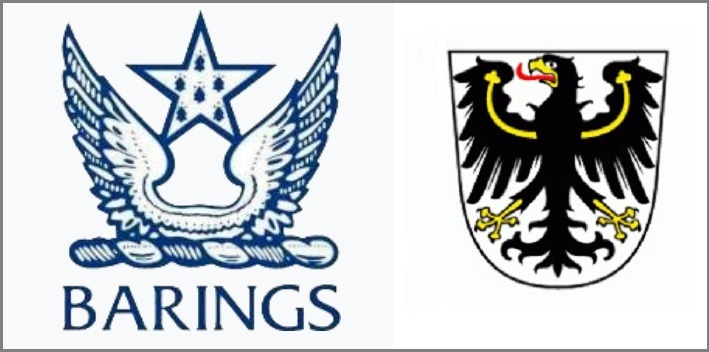
The observable patterns between the Baring brothers and the Dashwood brothers are uncanny. Both families were merchants, loaned money to governments, had incredible political influence, traded humans, and both bought huge tracts of land that would become significant parts of new states. The only real difference was that the East India Company was a slave trader, and Barings Bank financed a slave trader.
The logos of both companies embodied an eerie Prussian vibe:
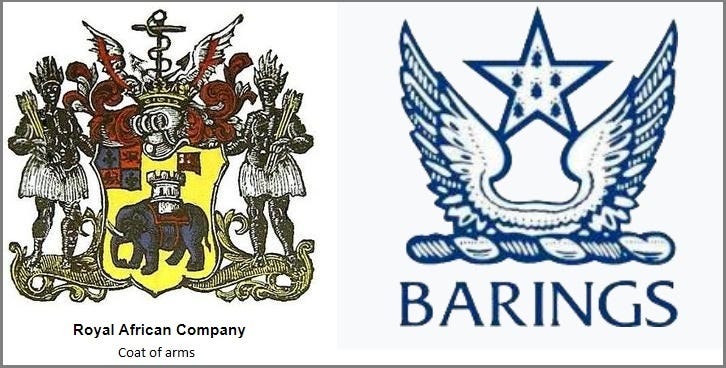
The German merchant’s influence over slaves in Europe was waning by the late 1800s, as the idea of human slavery became abhorrent. However, the #PrussiaGate articles have shown that German bankers and businesses were totally integrated with the central banking system that was being developed from 1871. The merchants would have to find new opportunities to monetize human labor. The previous networks created by the Royal African Company would provide such opportunities.
The “German East Africa Company” was a chartered colonial organization which brought about the establishment of German East Africa, a territory which eventually comprised the areas of modern Tanzania, Burundi, and Rwanda. The Company originated in 1884 as the Society for German Colonization with the aim of trading in Africa.
The timing of the German East Africa Company’s arrival during the 1871 – 1917 window is not coincidental. An open letter in November 1917 by Frank Weston, Bishop of Zanzibar, sheds light on the heinous business practices of the Kaiser in Africa, and concerns that freedom for the African people, may not be forthcoming:
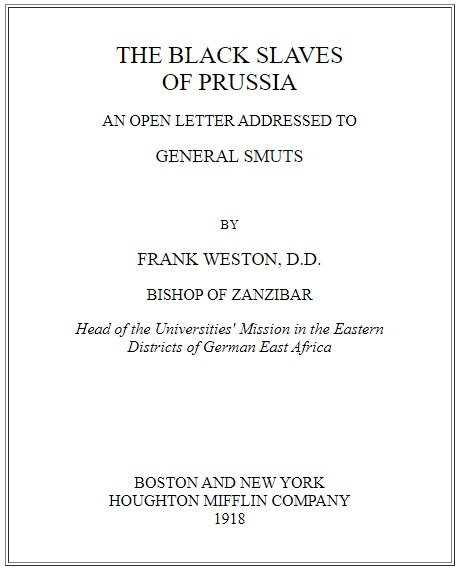


The letter goes on to outline horrible torture of African slaves, at the hands of the Germans. Weston concluded his discussion on this topic very powerfully, noting that the slaves had been robbed of the ability to take any initiative, whatsoever:

The detail and intent within Weston’s letter to London is profound. He clearly understood the stakes; he understood the need to end slavery; he understood the greed and brutality of the Prussian regime; he understood the need for true liberty and that it must be taken back from a tyrannical ruler. What he probably didn’t understand was that the Kaiser and the Crown may not have been quite as ‘separate’ as he believed. This truth was certainly not obvious in 1917, and we are really only just seeing this now, with the benefit of significant hindsight and research.
Weston’s final remarks in the letter reveal the heart of a true patriot. He was a man who knew that people’s freedoms embody a tangible authority, which must rightfully sit on a “universal throne”:
“This letter is my stake. For if the Germans return to rule here it will cost me all I hold most dear: my work, my diocese, and my numberless relations with the people of East Africa. All this I am glad to risk that these people may be set free, and our Government allowed to fulfil its plighted word, and raise liberty to a universal throne.”
Frank Weston’s comments about freedom and liberty would have made Frederick the Great turn in his grave, and every Prussian leader furious. Weston essentially spoke of a legal jurisdiction where the tyranny of Prussia did not occupy the throne. What a vision!
The Prussian hunger for slavery was insatiable. However, with slavery becoming socially unacceptable, the slave masters were forced to invent ways of monetizing slaves within their own country, rather than shipping them around the world. The German East Africa Company served as the perfect example of the Prussian transition towards globalism. Wars and Treaties were slowly being set in place ensuring control of each individual nation would soon be a reality. The means of control would be debt-servitude, rendering these nations as serfdoms.
The pending arrival of new money after WWI enabled businesses to flourish and new infrastructure to emerge. Such building programs would be the required distraction for humanity’s transition into debt-slavery. It was a clever strategy, because slavery and prosperity have always existed together. With new money creating the illusion of prosperity, the idea of slavery fell away very quickly.
Today we stand at an-equally significant precipice, to the one that Weston warned about in 1917. Today, ‘We the People’ are calling for an end to excessive government control and an end to the debt-slavery that has been placed upon sovereign nations, without appropriate audit or accountability. As was the case in Africa in 1917, the slaves are exhausted and simply want the tyrannical enemy to go from their land.
It is now becoming more obvious, that a group of merchant-bankers are ruling the earth like it is their own trade route. As in the days of the Hanseatic League, those who don’t participate are either subject to military violence or persecuted economically. As it was in 1694, it is the merchants who own the right to vote and establish the rules around credit. There is nothing new under the sun.
In typical Prussian style, at the end of one period of enslavement, the next phase of human enslavement had quietly been prepared, ready for deployment upon the people of the world.
To be continued…
http://mark-patton.blogspot.com/2016/03/the-wards-of-old-london-dowgate.html
https://www.merriam-webster.com/legal/legal%20person
https://www.historyofparliamentonline.org/volume/1690-1715/member/dashwood-sir-francis-1658-1724
https://www.britannica.com/event/Navigation-Acts
https://en.wikipedia.org/wiki/Livery_company#Precedence
https://voxeu.org/article/labour-scarcity-and-labour-coercion-serfdom-bohemia
